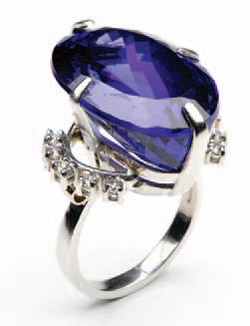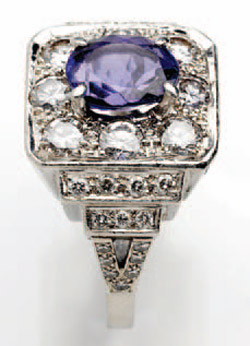|
All about Tanzanite We have all heard of the one that got away, the fishy tale in the pub, the publisher who turned down Harry Potter or the record label who thought the Beatles a rubbish band. They all had happy endings, a friendly pint in the pub, a rich and famous author or the greatest band in the world. The story of the discovery of tanzanite, however, is rather different. The received wisdom is that it was discovered by a tailor from Goa, living near the Merelani mines in Arusha, in the foothills of Mount Kilimanjaro, Tanzania, one Manuel D’Souza. Enter Ndugu Jumanne Ngoma (Swahili for playing music on Tuesday), a gypsum miner. On his way through the bush to visit relatives he saw some pretty crystals, some of them very large (a feature of Tanzanite) and collected about 5 kilos. As noone in Arusha was interested, he borrowed some money for his fare and travelled 300km to Nairobi. A company dealing in precious stones could not identify the mineral, but would investigate and let him know. They gave him his return bus fare, for which he left them his 5Kg bag of crystals and went home. In 2004, some 33 years later, he still had not heard from them. Ngoma sent some more of the crystals to a German firm who verified them as a variety of zoisite and claiming there was no current market for the crystals. A year or so later, Ngoma heard of Manuel D’Souza claiming to have discovered tanzanite and he began the long and arduous journey of claiming the discovery himself. After seventeen years, the Tanzanian Government’s mining ministry recognized Ngoma’s claim and certified him as the discoverer of tanzanite. However, by this time, the state-owned Tanzania Gemstones Industry had monopolized 10 square miles around the mines and permitted no–one else to mine. And Ngoma? Still mining gypsum. Tanzanite is a transparent gemstone, available in the less costly pale lavender colours through to the very costly saturated deep vivid ultramarines and sapphire blues, shot through with pinks and purples, (pleochrosim). It is not a terribly hard gemstone, 6.5-7 in hardness (talc = 1, diamond = 10) so care should be taken with ring-set stones. Cutting is difficult as the stone has perfect onedirection cleavage. In the rough, tanzanite crystals can have a brown-yellow tint, and this is corrected by heating the stone to around 500°C to give it its trademark beautiful colours; nearly all tanzanites have been heat treated. NEVER EVER clean tanzanite in an ultrasonic bath. I know of a most beautiful, voluptuous Tanzanite has to be my favourite gem, second only to diamond. The combination of a vivid Please see StrawberryWood’s website for more stunning pieces that can be created for you. StrawberryWood |
|
Search site
Upcoming Events
-
Rothwell Farmers Market
Saturday 20th April, 09:00 - 16:00 -
Mayor’s 90s Night
Saturday 20th April, 19:30 -
Shamblers Walk
Sunday 21st April, 13:30 -
Spring Bridge Drive
Tuesday 23rd April, 10:00 -
East Northants Association of The N...
Tuesday 23rd April, 19:30



